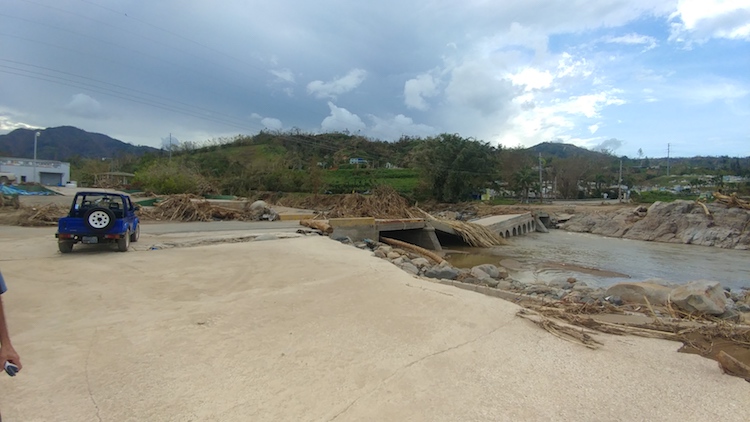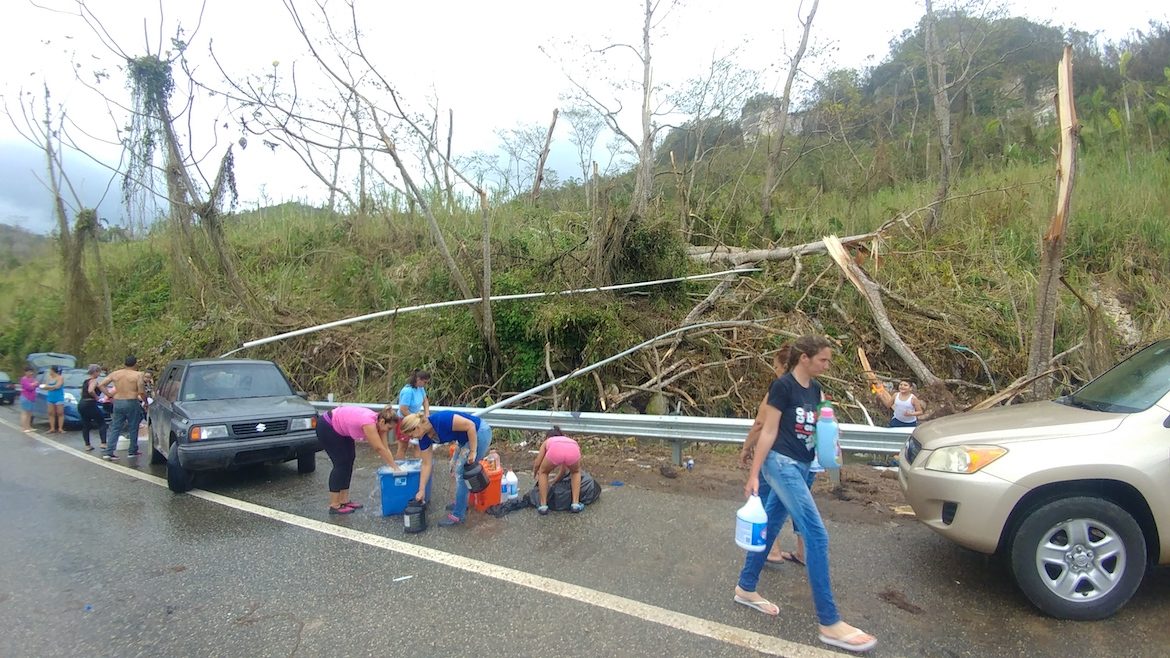He was jumping on logs, crouching under fallen trees, traversing paths of thick waist-deep mud, on a three hour journey on foot to the town. He was carrying only $2.00 in his pocket to buy toilet paper.
A week after Hurricane María struck Puerto Rico, Edgardo Matías is surviving in Guaonico, one of nine isolated neighborhoods in the municipality of Utuado. With no tap water and blocked access to go in the car to find food, his family collects spring water and wanders through the forest looking for vegetables, oranges and coconuts to survive. Assistance of the national, federal or municipal government has not yet arrived to these parts.
While in San Juan there are talks about the imminence of a humanitarian crisis, for him, his wife and two children, this crisis has already begun. “We are rationing the food, eating once a day, asking god for mercy”. There will be no food for long. Hurricane winds and floods damaged 80 percent of the country’s crops, the Department of Agriculture reported. In their neighborhood, a farm that was once overflowing with bananas is now destroyed.
As time passes by without receiving aid, isolated communities are exposed to illness and hunger. “Most of the mountainous municipalities have already cleared the main roads, but they still have isolated sectors,” said Omar Negrón, who advises governor Ricardo Rosselló on municipal affairs. La Fortaleza has not yet published a list with the name of the isolated neighborhoods in the mountainous zone. “The worst municipalities affected by the hurricane are in the mountains,” said Reinaldo Paniagua-Látimer, executive director of Puerto Rico Mayors Federation.
Utuado’s Highway 603, which leads to Edgardo Matías’ house, was not only blocked by large trees and soil from landslides. “The mountains near my house melted. We are walking through a shifting muddy land in which you sink. I have had to help myself hand in hand with my children. We have gone back to ancient times, bathing in the river with muddy water. In this situation, human pride crumbles down.”
Clearing the roads is the previous step for water and food to arrive. Utuado’s Highways 605, 612, 607, 146 and 123 were totally blocked last Tuesday. The infrastructure of 11 bridges had been affected, three of which have entirely collapsed. The passage of Highway 10 through the center of the Island -the main route between the cities of Arecibo and Ponce-, was interrupted. One of the bridges that connects with the Utuado Campus of the University of Puerto Rico, has collapsed. “We have to cut trees, push them aside, but when we clean, we find that there are roads that no longer exist,” said Héctor Cruz, director of the Municipal Emergency Management Office.

Eliván Martínez Mercado | Centro de Periodismo Investigativo
One of the bridges that connects with the Utuado Campus of the University of Puerto Rico, has collapsed.
Utuado, the third largest municipality in Puerto Rico, with more than 33,000 inhabitants, has to face the humanitarian crisis with a municipal government that was already implementing austerity policies before the hurricane. The municipal employees had suffered cuts in wages and working hours. While Puerto Rico is in bankruptcy for defaulting on a $74 billion debt, the ability of municipalities to raise money from the central government to deal with the emergency is affected. City councils face a reduction of $350 million in ten years, which represents 100% of central government contributions, according to the fiscal plan approved by the Fiscal Control Board, the federal entity that commands the country’s finances.
As of yesterday, Utuado’s mayorship only had two mechanical shovels, four bulldozers, two compact Bobcat type work vehicles and a one caterpillar chain machine for work in 23 neighborhoods, plus the help of two private companies, according to Cruz.
A non-incorporated territory of the US, Puerto Rico is home of 3.5 million citizens with US passport. President Donald Trump announced his visit to the Island for next Tuesday.
Hurricane María, catalogued by Governor Rosselló as the worst disaster in Puerto Rico’s history, has displaced more than 11,000 people to 179 shelters around the Island, while the island’s infrastructure, primarily electricity and roads, is destroyed. In Utuado, there were five shelters housing 286 people seven days after the hurricane, but the municipal government expected that the amount would increase after the arrival of persons from isolated communities.
The first wagon with water supplies and food rations arrived on Monday at the Federal Emergency Management Agency (FEMA) in Utuado. “The priority has been for shelters and the emergency response workforce. We started distributing food that we had picked it up and planned on sending to Vieques when it was affected by Hurricane Irma,” according to First Class Sergeant Alejandro Echevarría, who runs the US Army National Guard facility in Utuado.
Edgardo Matías had not heard that there were uniformed men with assault weapons in the village, and military trucks moving in the streets. “Did the Americans come? And the ships? Did the president arrive?” He did not know that there were communities in Toa Baja with more than 4,000 displaced persons, some of whom had been rescued by helicopter from their roofs, or that a dam reported threat of failure that would cause flooding between the villages of Quebradillas and Isabela.
“Here we have no idea about what happened in Puerto Rico,” said Matías, surprised by the magnitude of the catastrophe. Utuado’s WUPR 1530 radio station was only partially operational on Tuesday, and the cell phone signal had not yet arrived. Meanwhile, he settled for the chicken turnover they put in his hands when he was on his way to town. It was the first hot meal he had in six days.
Comments to: emartinez@periodismoinvestigativo.com




Need help request for Martial Law
lo